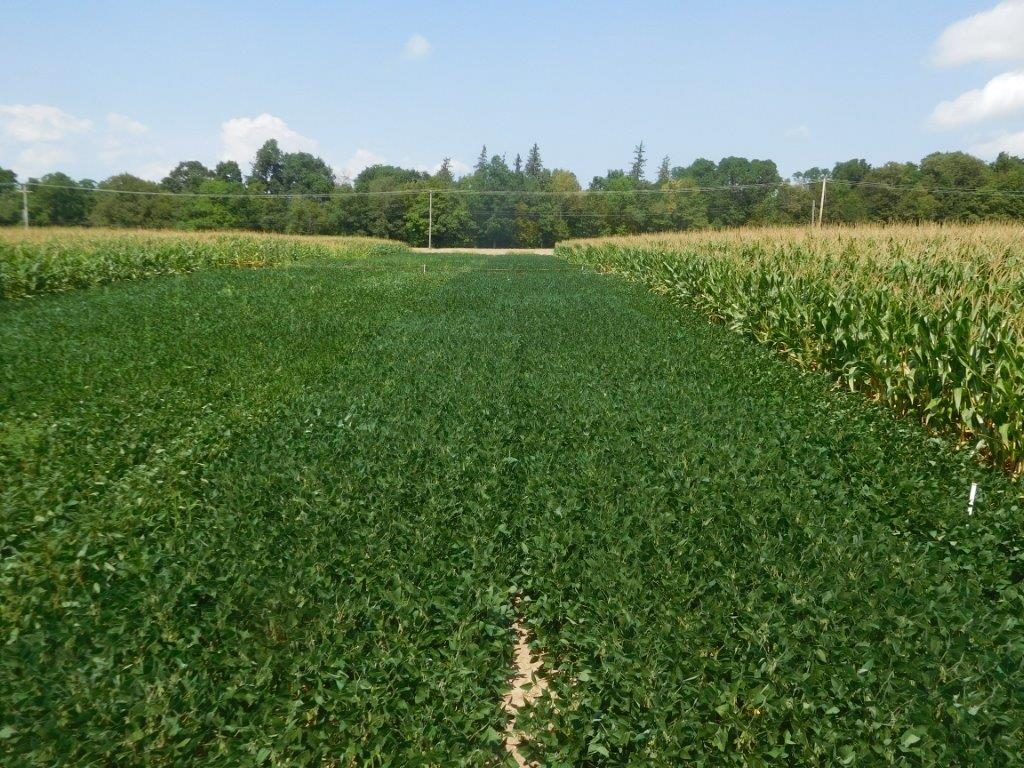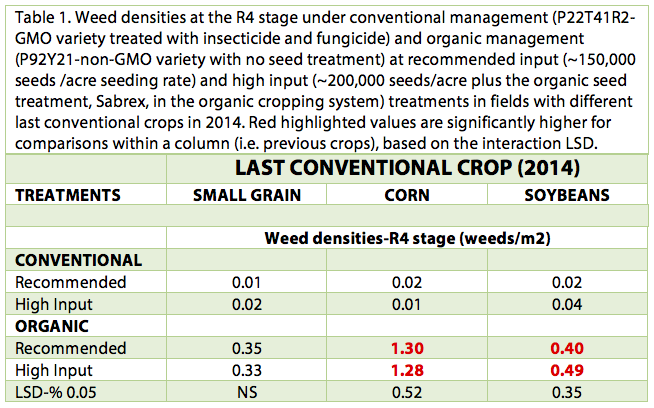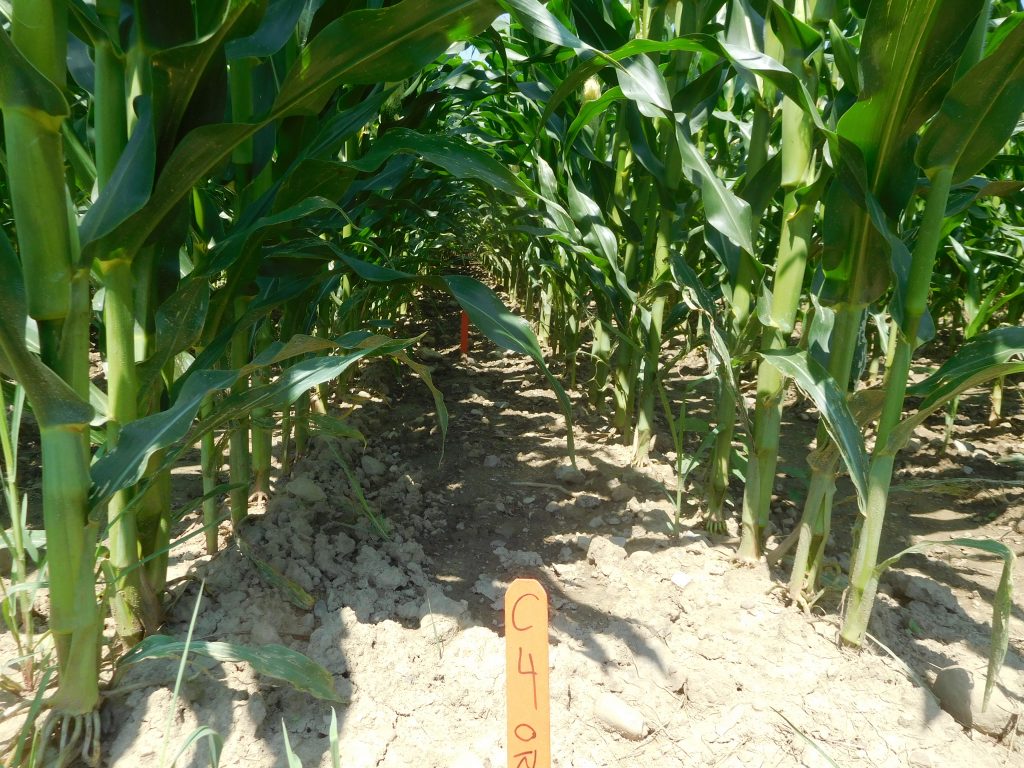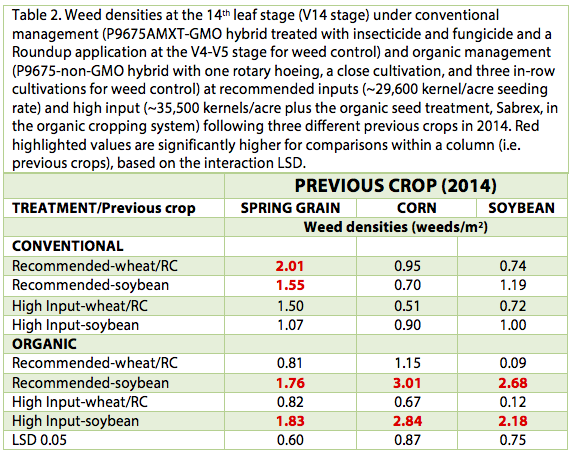Bill Cox and Eric Sandsted
Soil and Crop Sciences Section, School of Integrative Plant Science, Cornell University

We initiated a 3-year study at the Aurora Research Farm in 2015 to compare different sequences of the corn, soybean, and wheat/red clover rotation in conventional and organic cropping systems under recommended and high input management during the 3-year transition period (2015-2017) from conventional to an organic cropping system. We provided a detailed discussion of the various treatments and objectives of the study in a previous soybean article (https://blogs.cornell.edu/whatscroppingup/2015/09/16/emergence-early-v2-stage-plant-populations-and-weed-densities-r4-in-soybeans-under-conventional-and-organic-cropping-systems/). This article will focus on weed densities in soybean at the R3-R4 stage in 2017.
Corn preceded soybean in the rotation in this study. The fields were plowed on May 17 and then cultimulched on the morning of May 18, the day of planting. We used a White Air Seeder to plant the treated (insecticide/fungicide) GMO soybean variety, P22T41R2, and the non-treated non-GMO variety, 92Y21, at two seeding rates, ~150,000 (recommended input) and ~200,000 seeds/acre (high input). The varieties are not isolines so only the maturity of the two varieties and not the genetics are similar between the two cropping systems. We treated the non-GMO variety in the seed hopper with the organic seed treatment, Sabrex, in the high input organic treatment. We planted soybean in the typical 15” row spacing in the conventional cropping system and the typical 30” row spacing (for cultivation of weeds) in the organic cropping system.
We applied Roundup (Helosate Plus Advanced) on June 21 at ~32 oz. /acre for weed control in conventional soybean (V4 stage) under both recommended and high input treatments. We used the rotary hoe to control weeds in the row in recommended and high input organic soybean at the V1-2 stage (June 2). We then cultivated close to the soybean row in both recommended and high input organic treatments at the V3 stage (June 12) with repeated cultivations between the rows at the V4-V5 stage (June 22), the V5-V6 stage (June 28), the R1 stage (July 5), and the R2-3 stage (July 20). We estimated weed densities at the R4 stage (August 14th) by counting all the visible weeds along the 100 foot plot across the entire 10 foot plot width.
Conventional soybean had very few visible weeds in 2017 with most plots totally weed-free, regardless of input treatment (Table 1). Weed densities in the preceding conventional corn crop were also very low in the dry 2016 growing season, fewer than 0.40 weeds/m2 in all treatments (https://blogs.cornell.edu/whatscroppingup/2016/07/27/emergence-plant-densities-v3-stage-and-weed-densities-v14-stage-of-corn-in-conventional-and-organic-cropping-systems-in-2016/). Evidently, robust soybean vegetative growth associated with the wet June and July conditions coupled with a low number of seeds in the weed seed bank allowed conventional soybean to outcompete the relatively low number of emerging weeds after a timely Roundup application in 2017.
Although weed densities were greater in organic compared with conventional soybean in 2017, organic soybean had relatively low weed densities, averaging less than 0.50 weeds/m2 in fields that had a spring grain or soybean as the last conventional crops in 2014 (Table 1). Unlike the 2015 and 2016 growing seasons, high and recommended input treatments had similar weed densities in organic soybean, despite the different seeding rates. Organic corn, the preceding crop, also had relatively low weed densities in 2016, fewer than 1.25 weeds/m2 in all treatments. Although weed densities were low, leaf area and biomass of all weeds in organic soybean were quite high. Unfortunately, August turned dry at the Aurora Research Farm (1.47 inches of precipitation) so the robust weeds would compete with organic soybean for the dwindling available soil water supply during the critical R4-R5 stage in soybean development. Organic and conventional soybean, however, yielded similarly in 2015 when dry August conditions prevailed (1.36 inches) (https://blogs.cornell.edu/whatscroppingup/2015/11/09/soybean-yield-under-conventional-and-organic-cropping-systems-with-recommended-and-high-inputs-during-the-transition-year-to-organic/). It will be interesting to see if that holds true in 2017.
In conclusion, weed densities were exceedingly low in conventional soybean, which received a timely single application of Roundup at the recommended rate. Weed densities were much higher in organic soybean but still relatively low. Evidently, a timely rotary hoe operation followed by a close cultivation to the row and repeated cultivations between the row can maintain satisfactory weed control in organic soybean in the 3rd year into an organic cropping system, especially in a year with robust soybean vegetative growth. We expected an increase in weed densities with each successive year in the organic cropping system because of an increase of weed seeds in the weed seed bank, but that has not materialized so far. In 2018, organic soybean will follow corn in a soybean-wheat/red clover-corn rotation with relatively low weed densities in organic corn in 2017 (average of 0.60 weeds/m2) compared with much higher weed densities in organic corn in a corn-soybean-corn rotation in 2017 (average of ~2.40 weeds/m2) (https://blogs.cornell.edu/whatscroppingup/2017/08/10/wheatred-clover-provides-n-and-may-help-with-weed-control-in-the-organic-corn-soybean-wheatred-clover-rotation/). This should shed some light on how much the weed seed bank influences weed densities and subsequent yields in organic soybean in the 4th year into an organic cropping system.




